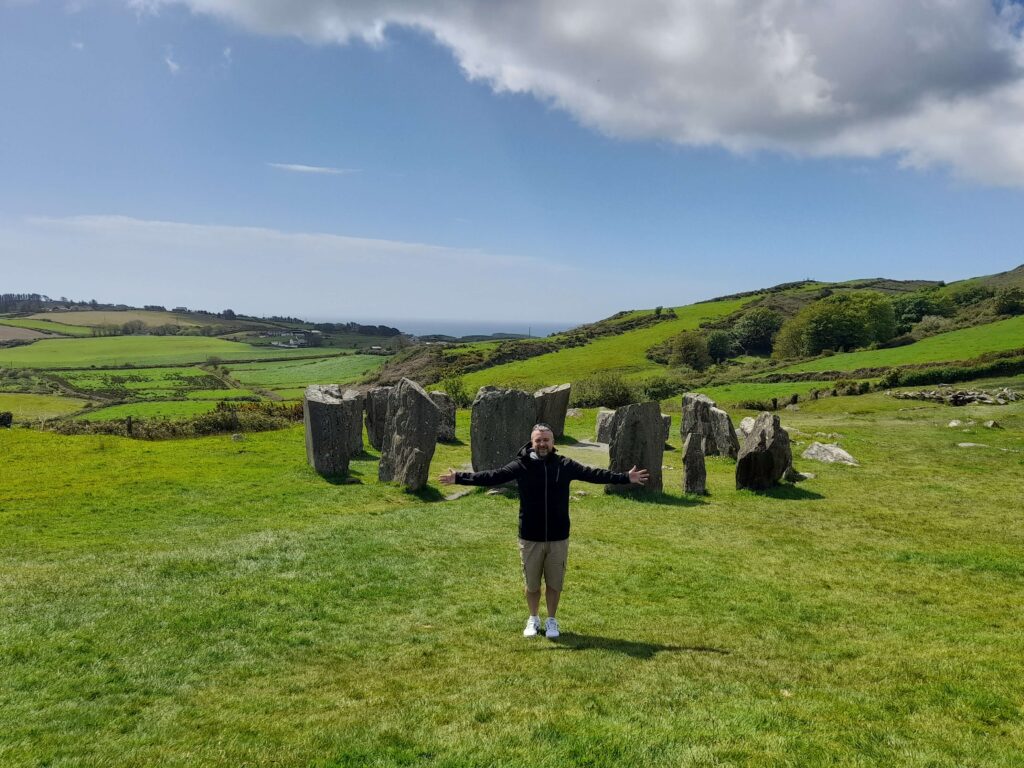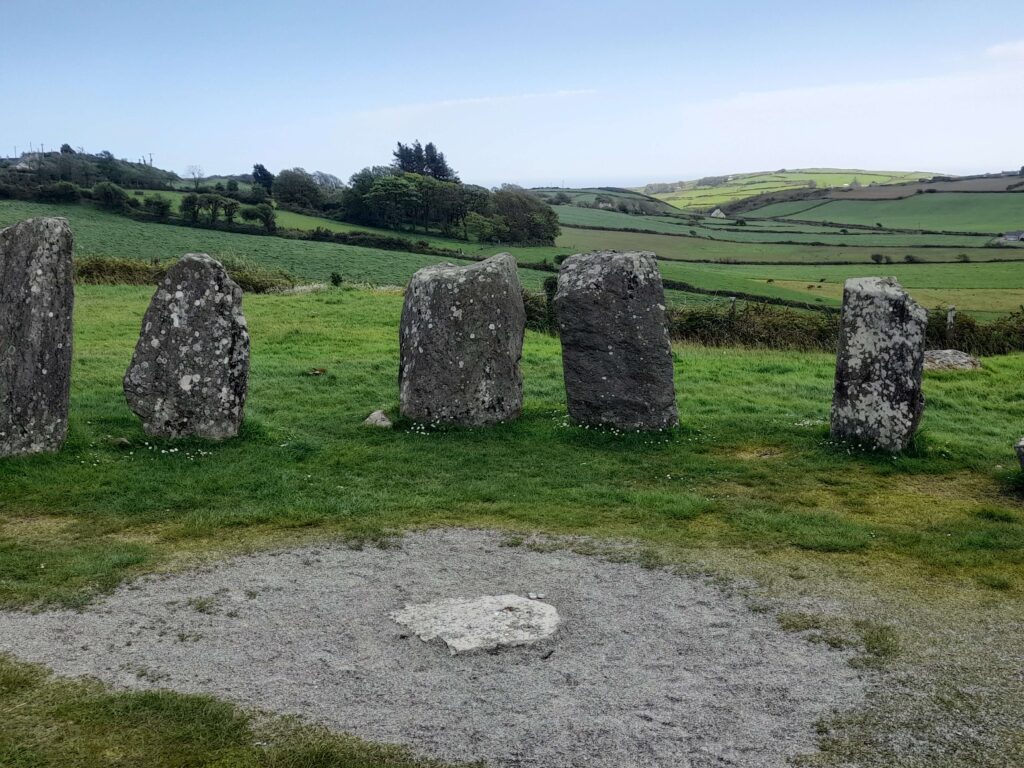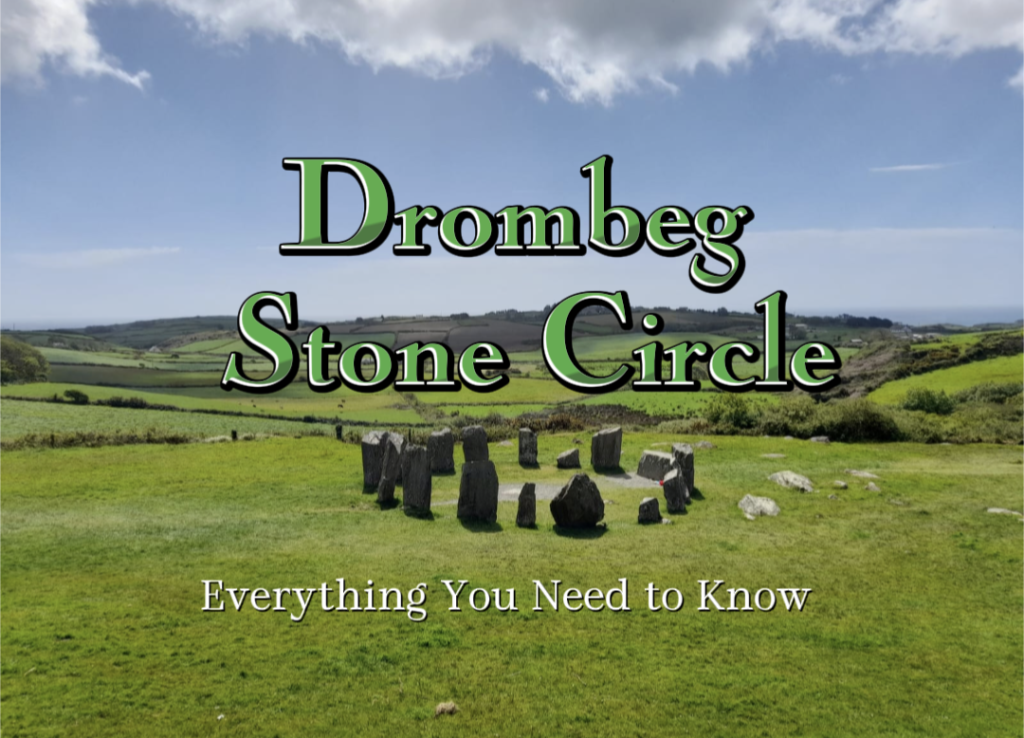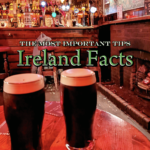Last updated on March 13th, 2025 at 11:29 am
The Drombeg Stone Circle is one of the best ancient sites in Ireland. Not only is this megalithic monument spectacular to see, but it is also a free attraction to visit!
Even though Kevin hails from County Cork, it wasn’t until 2022 that we finally visited the Drombeg Stone Circle for the first time. Sometimes you just forget about the amazing attractions right in your own backyard…..
While smaller and less famous than Stonehenge, this ancient stone circle remains a must-visit attraction in Cork, for both locals and tourists visiting Ireland.
This article will provide all the details for visiting the “Druids Altar”. We will tell you about the fascinating history of the Drombeg Stone Circle and highlight other ancient megalithic sites in Ireland that are worth visiting.
What Is Megalithic?
Did you know that there are over 1300 stone circles in Ireland, the UK, and the Brittany region of France? Out of all these ancient megalithic sites, Drombeg Stone Circle stands out as one of Ireland’s best megalithic sites.
The word “megalithic” comes from the Greek words “megas,” meaning “large,” and “lithos,” meaning “stone.” In archaeology, megalithic refers to structures or tombs built using large stones, often weighing many tons, that date back to prehistoric times.
There are different types of megalithic structures such as megalithic tombs, passage graves, chambered cairns, dolmens, stone circles and fortified settlements.
Some of the most famous megalithic monuments include Stonehenge in England, Carnac stones in France, Newgrange in County Meath, Ireland, and the Pyrenees’ mysterious structures.
These ancient megalithic structures were constructed for a range of purposes. Some of these sites served as tombs, where the dead were laid to rest. Others were likely used as ritual centers, where people gathered to perform religious or ceremonial practices back in Pagan times.
Is Drombeg Stone Circle Worth Visiting?
The word Drombeg means “the small ridge” when translated from the Irish language, and as previously mentioned, it is also referred to as the “Druids Altar” by the locals.
Visiting the Drombeg Stone Circle in County Cork, offers a glimpse into Ireland’s ancient pagan traditions and past. Besides the stone circle you can also visit other ancient sites such as the remains of stone dwellings and a cooking facility called a fulacht fiadh.

What is a fulacht fiadh you ask – During the Bronze Age in Ireland, a fulacht fiadh was a type of cooking pit used to prepare meals. Typically, it involved filling the pit with water and heating large stones in a nearby fire. Once heated, these stones were removed and placed into the water, causing it to boil – Dinner sorted!
When you are at one of Ireland’s best ancient sites, take a moment to embrace the surrounding scenic landscape of County Cork. This is a classic-looking Ireland when you envision it, with continuous fields of different shades of green. It is a peaceful setting that provides a tranquil and spiritual atmosphere, especially when you have the entire megalithic site to yourself!

Where Is Drombeg Stone Circle?
Drombeg Stone Circle, located around 70 kilometers from Cork City in the scenic Southwest of Ireland, can be reached by car in just over an hour from the city.
The ancient megalithic monument is only a 5-minute drive from the picturesque village of Rosscarbery and sits centrally between Clonakilty and Skibbereen, making it an excellent addition to your day trip itinerary when visiting these must-visit County Cork towns.
Renting a car is the best way to visit these wonderful attractions and explore the hidden gems in Cork that are scattered throughout this gorgeous region.
From Cork City take the N71 Route towards Clonakilty, through the towns of Innishannon and Bandon. Then, from Clonakilty take the R597 road towards Rosscarbery.
Keep following the road through Rosscarbery and continue on the R597 for a few kilometers following the signs until you reach the turnoff for the Drombeg Stone Circle. Easy eh!
Ireland Travel Tip – The best way to explore Ireland’s best attractions such as the Cliffs of Moher and the Ring of Kerry is by car – click to get a free quote for Car Rental in Ireland. However, if you don’t want to drive yourself, an incredible alternative is to book the perfect Ireland Tour with Brendan Vacations. Sit back, relax, and experience a uniquely tailored trip that is planned, managed, and personally delivered by a passionate team of Celtic Experts.
Is there Public Transport To Drombeg Stone Circle?
Unfortunately, there isn’t a direct public transport route from Cork City to Drombeg Stone Circle. However, you can still access it by bus with a couple of transfers, but it will take a bit of effort and time.
Bus to Clonakilty – From Cork City, catch a bus to Clonakilty, where you have the option to either take a taxi directly to the stone circle or catch a local bus to Rosscarbery and then arrange a taxi. Walking is possible from Rosscarbery, but it is a distance of 5 km (3 miles) oneway.
If you are using public transport then consider staying in the vibrant and welcoming town of Clonakilty, for its fun atmosphere, great attractions, and some of Ireland’s finest pubs!
When Was Drombeg Stone Circle Built?
It is believed that the Drombeg Stone Circle in County Cork, Ireland was built during the Bronze Age over 3000 years ago.
This megalithic tomb of ancient Ireland is made up of 17 large stones, 16 of them standing and one lying. The lying stone is called The “Druids’ Altar” and is presumed to have had the function of an altar and a sacrificial table. It is also believed that two of the largest stones were used as an entrance to the Drombeg Stone Circle.
However, what is definetly known is that the Druids Altar was built orientated towards the west where the sun sets during the winter solstice.
Similar to the Great Pyramids and Stonehenge, it’s astonishing that people constructed these megalithic monuments in ancient times without the aid of modern building equipment that we have today.

Because the Drombeg Stone Circle in Ireland was constructed in prehistoric times, it means that there are no historical records of who exactly built the monument. It is presumed to have been constructed by the Bronze Age inhabitants in the County Cork region, although whether they were nomadic or settled remains unknown.
What Was Drombeg Stone Circle Used For?
That is the million-dollar question as there is no definitive answer but only hundreds of theories and speculations.
Many historians believe it to have had ritualistic and ceremonial significance. Some theories suggest it was used for religious or spiritual ceremonies and gatherings.
Another suggestion is that it was used for astronomical observations due to its alignment with celestial events like the winter solstice.
Finally, some suggest that Drombeg Stone Circle served as a communal meeting place for social activities. The presence of the fulacht fiadh (cooking pit) supports the idea of its use for communal cooking and feasting during gatherings.
So to summarize it all, there are many theories, but no one exactly knows! What we do know, is that it is one of Ireland’s best megalithic sites and a must-visit attraction in Cork.
There are many great things to do in County Cork besides visiting the Drombeg Stone Circle. The surrounding area boasts some of Ireland’s most stunning towns, ancient castles, Ireland’s most southern Point at Mizen Head to name only a few attractions to visit in the Rebel County! Simply click below to find out more detail!
Historical Discoveries
In 1957 the drombeg Stone Circle area was excavated by archaeologists who discovered an ancient firepit in the middle of the megalithic tomb.
Inside the firepit. archaeologists discovered the remains of a cremated adolescent child. Which has led researchers to suspect that the Drombeg Stone Circle may have been a location where human sacrifices took place.

Other archaeological finds at Drombeg Stone Circle included flint tools, animal bones, and remnants of ancient structures. Carbon samples taken from the site confirmed that the megalithic tomb was actively used during the period between 1100 and 800 BC.
Other Things to do in County Cork
The largest county in Ireland, there are many great things to do in County Cork. Click the link to discover the best things to do in Cork.
- 12 Great Attractions to Visit in Cobh, Ireland.
- Mizen Head – Visit Irelands Most Southern Point.
- The Best Hotels in Cork.
- 16 Best Things to do in County Cork.
- 5 Most Beautiful Towns in County Cork.
Best Ancient Sites To Visit In Ireland
Ireland is home to many megalithic sites. These ancient structures include passage tombs, stone circles, and dolmens, all of which hold secrets and stories from Ireland’s rich history. These ancient megalithic sites are dispersed throughout Ireland, with a high concentration found in counties such as Cork, Meath, Sligo, Clare, and Kerry.
Newgrange – A UNESCO heritage site and Ireland’s most famous megalithic site.
Located in County Meath, Newgrange is a prehistoric passage tomb with ancient stone carvings. The structure was built around 3200 BCE, making it older than Stonehenge and the Great Pyramids.

But what it is most famous for is its alignment with the winter solstice, a celestial event that occurs around December 21st every year. During this period, a beam of sunlight alignes with the passage tomb’s entrance and illuminates the inner chamber.
Newgrange is often considered Irelands best megalithic site, and it’s essential to book tickets in advance to ensure access. Due to Newgranges’ immense popularity, tickets tend to sell out months in advance, so it’s highly recommended to book your spot well ahead of time to avoid disappointment.
Poulnabrone Dolmen: Located in County Clare, Ireland, the Poulnabrone Dolmen is a classic Megalithic portal tomb dating back to around 4200 BCE. This ancient structure is composed of a large capstone poised supported by four imposing portal stones, earning its status as one of Ireland’s most iconic dolmens. Visitors can enjoy free parking and entry.

Loughcrew Cairns: Another one of Ireland’s best megalithic sites, Loughcrew cairns is located in County Meath, the Loughcrew Cairns are a collection of passage tombs dating back to the same period as the famous Newgrange.
The Loughcrew Cairns has an impressive array of megalithic structures, some of which are precisely aligned with the celestial events of equinoxes and solstices. Unlike Newgrange, this site offers free admission to visitors, making it an accessible and awe-inspiring destination for anyone interested in exploring Ireland’s ancient heritage.
Brownshill Dolmen: Situated near Carlow town, Brownshill Dolmen is the largest of dolmens in Ireland, with a massive capstone estimated to weigh over 100 tons. It is believed to date back to the Neolithic period and is free to visit.
Situated near Carlow Town, Brownshill Dolmen is Ireland’s largest dolmens with a colossal capstone estimated to weigh over 100 tons. This ancient Neolithic structure was built during the Neolithic period. Visitors can explore this monumental site without any admission fee, making it a must-visit attraction for anyone interested in Ireland’ history.
Carrowmore Megalithic Cemetery: Located in County Sligo, Carrowmore is one of the largest megalithic cemeteries in Ireland, with over 60 tombs dating back to the Neolithic period. The site includes passage tombs, dolmens, and stone circles.
In the picturesque County Sligo, Carrowmore Megalithic Cemetery is Ireland’s most extensive and ancient megalithic cemeteries, comprising over 60 tombs that date back to the Neolithic period. This megalithic site is home to an array of different structures, including passage tombs, dolmens, and stone circles, offering a glimpse into the lives and traditions of Ireland’s early inhabitants.
Read more about the Greatest 10 Megalithic sites in Ireland.
Take a moment to find out the costs of a once-in-a-lifetime holiday, and start planning your Ireland Holiday now!!!
Visiting the Drombeg Stone Circle offers a glimpse into Ireland’s ancient past, rituals, and beliefs. Nestled amidst the scenic landscapes of County Cork, this megalithic site offers a tranquil and historic retreat, all for free!
Have you had the chance to visit the Drombeg Stone Circle, or any other megalithic site in Ireland?
If so, we’d love to hear about your experience visiting megalithic tombs of ancient Ireland or anywhere else in the world.
Please feel free to leave a comment or question below, and, make sure to follow our latest adventure around the world through our socials.
Slán go fóil


This post contains affiliate links. If you click on the links to make a purchase, we will earn a small commission. This is at NO EXTRA COST to you. This is a free way to support us and allow us to continue to create inspiring adventure travel guides.





